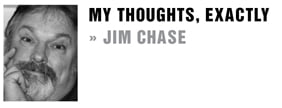
Many cities have a symbol or image that, over time, comes to represent that place. You see the image, you think of the place. For example, when you see the distinctive architecture of the Sydney Opera House, you think of Australia. Same goes for the Coliseum in Rome, New York’s Empire State Building, the Eiffel Tower and other internationally known city icons.
Closer to home, we have the Eagle Rock, the Hollywood sign, or that kitschy-spaceship-Jetsons-inspired restaurant in the center of LAX. See the image, know the place.
A recent e-mail I received from a concerned CV Weekly reader (which I’ll address specifically in next week’s column) got me thinking about what icon might be used to represent the collective communities of the Crescenta Valley. What would we print on picture postcards for tourists? What image could be carved into the bedrock of the Verdugos to represent our beloved hometown for all time?
My suggestion — a trash bin.
No kidding. Drive through just about any neighborhood in these foothills and look around. What’s the most prevalent thing? Yep. Row after row of brown, blue or black plastic trash bins. Huge, hulking, horrendously unsightly trash bins. Trash bins lined up at the curb. Trash bins parked like sentinels along driveways, in front of garages, in front of mail boxes, wedged between parked cars, on front lawns, sidewalks, alongside fences, and knocked on their sides with lids flung open like gaping Pac-Man mouths.
They’re big. They’re ugly. And since five years ago when BFI announced the beginning of “automated Trash and Recycling Services,” the bins are everywhere. I make no claims of being a trash can connoisseur, and I can’t for the life of me explain why this matters, but I’ve noticed that the original “vintage” BFI bins are a dull matte finish and made from a somewhat flexible material. The newer bins from Allied Waste are glossy and made from a cheaper-looking, rigid plastic. Personally, I’d rather have the matte-finish BMI cans littering the streets and driveways of our neighborhood than the glossy AW models. Call me snooty, but the hard, shiny plastic somehow looks tackier. Yeah, I know. I live an exciting life.
Until I received the above mentioned e-mail from a reader who is understandably distraught over the sheer number of these unsightly cans constantly left in plain view, my primary concern with the containers has been their ridiculous size. At an official 96-gallons per bin, they’re only slightly smaller than a Navy frigate. You may as well try to hide a Hummer alongside of your house as try to conceal not one, but three of these behemoths. After all, every household is required to use a brown bin for household refuse, a blue bin for recyclables and a black bin for green waste. (Which begs the question, why not a green can for green waste?)
Our old conventional trash cans used to fit neatly along the walkway at the side of our garage. Sure, some of them were old, beat up galvanized metal cans that looked like rejects from a Stomp performance. Some were plastic with long gaping slits up the side. But at least I was able to store all of them completely out of sight.
When BFI banished traditional cans in favor of the new larger-than-a-Lexus bins, we tried at first to store the new containers where we kept the old ones. Which would have been okay, if we didn’t mind using ropes, carabineers and pitons to climb over the massive things in order to get from the front yard to our side door.
And, because building an aircraft hanger to conceal the new bins wasn’t an option, we, like far too many of our fellow Foothillians have since had big ol’ honkin’ cans as a permanent part of our front landscaping. Yuck.
I’ll have more trash talk next week.
Until then,
I’ll see you ’round town.
